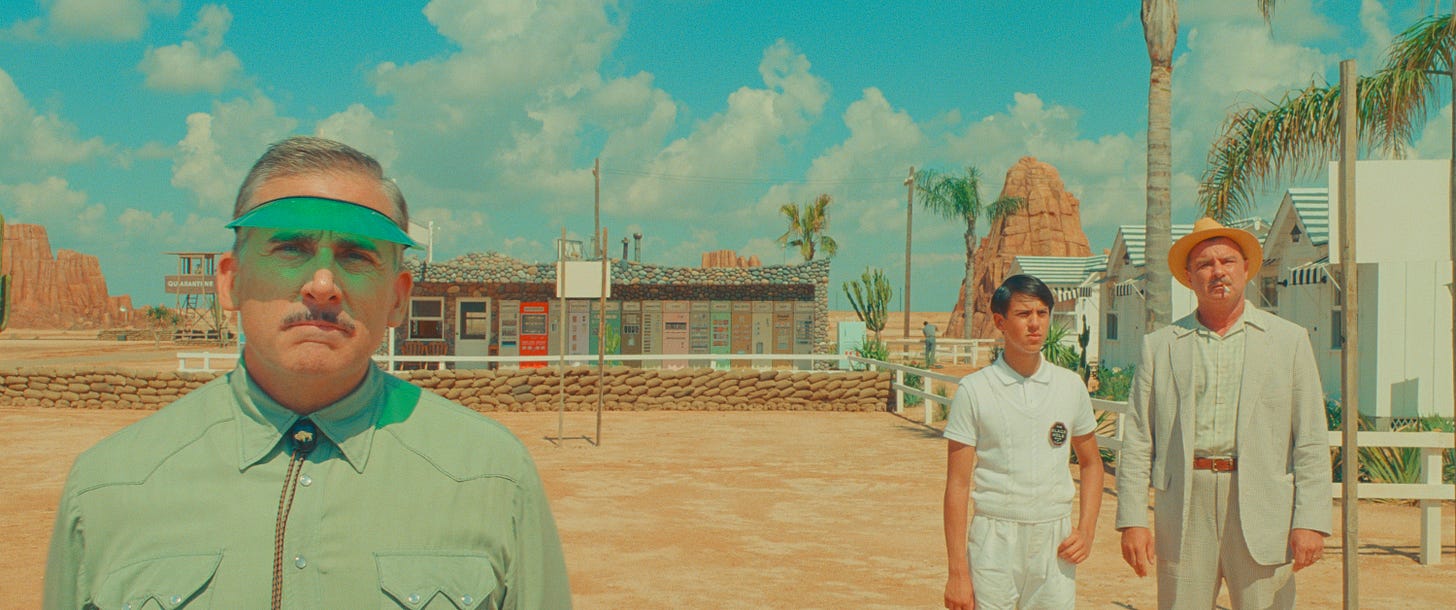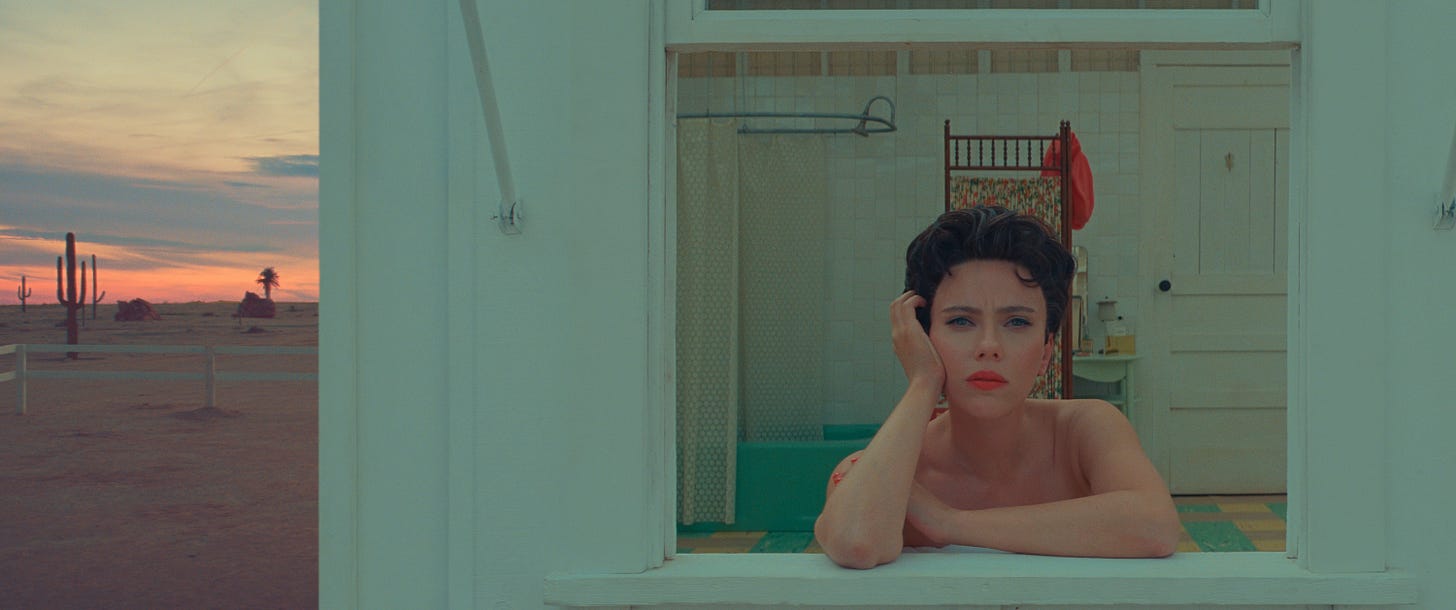"Asteroid City": A Celebration of Storytelling and Andersonian Stagecraft
In Wes Anderson's new film, the director's distinctive style reaches its apogee. It may also be his most profound film yet.
Stagecraft is the art of making one thing look like another. Most directors seek to dissolve the boundaries of the screen. Wes Anderson wants you to pay special attention to them – right before he makes them vanish, and before he makes them reappear again. If his last film, The French Dispatch (2021), was an homage to the halcyon days of journalism, when intransigent magazine editors sent reporters to foreign bureaus with no prompts and bottomless expense accounts, Asteroid City is a celebration of the act of storytelling, told using every available Andersonism.
We are first greeted by a television presenter (Bryan Cranston), a Walter Cronkite analogue known to us only as “The Host”, who tells us we are about to see a televised version of a play (also called Asteroid City) by the playwright Conrad Earp (Edward Norton), set in the fictional, less-than-one-stoplight town of Asteroid City, somewhere in the desert of the American southwest.
Cuts between this framing and the events of the play are led by full-screen cue cards (“Act I, scenes i-ii”), as we are taken from the black-and-white "Academy ratio" of 35 mm film and plunged into sun-bleached, pastel widescreen (“We’re not in Kansas anymore”).
Small sandstone hillocks and cactuses speckle the horizon and a two-lane road runs a straight line between a one-pump gas station and a luncheonette.
A crowd of eccentrics slowly stream into this boomtown (where conversation between the characters is occasionally interrupted by the detonation of atomic bombs, for testing, as little gray mushroom clouds spring up on the horizon) to attend an annual science convention. Augie Steenbeck (Jason Schwarzman), a newly widowed war photographer, arrives with his brainiac teenage son Woodrow, one of a few “Junior Stargazer” winners, and three impetuous small daughters. Midge Campbell (Scarlett Johansson) is an actress, appearing like a cutout from Vertigo (1958) or Psycho (1960), and mother to Dinah, another precocious Junior Stargazer.
When the ensemble is complete (Tilda Swinton as a local scientist, Jeffrey Wright as a General and the convention’s emcee, three other Junior Stargazer awardees and their parents, local school children, cowboys, and a band of musicians), the convention can begin. As the assembled look up at the night sky to view a rare cosmic event, a green light mysteriously appears. Moments later, a spaceship quietly descends to Earth. A slim, shy alien (an unrecognizable Jeff Goldblum on stilts) disembarks, and silently picks up the bowling ball-sized asteroid that had crash-landed there long ago, before boarding the ship and receding back up and out of view.
“Just keep telling the story.”
Eager to keep a lid on this development, the US government imposes a quarantine (wink) on everyone in Asteroid City, who are all subjected to mandatory medical and psychological assessments. Trapped in the desert, the wiz kids attempt to interpret data from satellite receivers and telescopes, the local school children speculate about the nature of this alien (Is it benign?), the parents grow restless, and the government sends in the military.
A romance develops between Augie and Midge, who inhabit adjacent quarters, as they converse across the space between their screenless windows. Augie helps Midge run lines as she prepares for a new role, and their discussion – of grief, loss, and guilt – takes sudden plunges into depths of emotion (riding on Johansson’s magnificent talent) whose effect is augmented because of that emotional flatness that characterizes line delivery in Andersonland.
A middle layer in the film’s framing emerges: the actor playing Augie in Asteroid City the play, Jason Hall, doesn’t understand the motivation behind his character, and seeks out in turns the playwright as well as the play’s director, Schubert Green (Adrien Brody) for advice. (These are method actors after all.)
We’ve arrived at the heart of the movie. At each level of the film’s framing – in the television studio, in the Actor’s Studio, and on the brilliantly-colored set where a visit from a UFO throws a whimsical science convention into disarray – Anderson ventriloquizes through his characters: How do we act in the face of uncertainty? What do you do when you don’t know how to continue the bedtime story? How do we react when confronted by something utterly foreign and puzzling? Schubert Green tries to cheer up his lead: “Just keep telling the story.”
In the final tableau, a dismayed Jason Hall steps off set through a side door and runs into an actress (Margot Robbie) who was to star as his character’s wife in the play but whose only scene was cut. In the narrow alleyway below, two marquees read “Death of a Narcissist” and “Circle the Wagons,” inviting speculation on as many references as you can come up with.
The “set” of the play Asteroid City has no wings and no backstage. Eventually, even The Host, whose stated purpose is to guide us through this drama, himself cannot keep the levels of the frames straight, and shows up by accident two levels too deep in full color, is looked at quizzically by Midge (or perhaps, the actress Mercedes Ford in character), and has to excuse himself.
The most common critique of Anderson is that his movies are marshmallow fluff – sweet but devoid of substance, artifice rather than art. To the certain distaste of his detractors, almost every Andersonism is here pitched to perfection. The flatness of tone and uniformity of expression among the cast is nearly absolute. As for drawing attention to the frame, to the machinery of storytelling, Anderson wants you to see the marionette strings even at the center of the film: where the road that runs straight down the middle of Asteroid City reaches the horizon, you can almost make out where the green screen starts.
There are themes that recur in Anderon’s movies like leitmotifs: precocious children, the innocent affection between boys and girls on the cusp of sexual awareness (see also Moonrise Kingdom), strained family relations (Darjeeling Limited and Royal Tenenbaums), the passionate defense of the beautiful in the face of the tyranny of functionalism (Grand Budapest Hotel). Asteroid City delivers on these while declaring an ode to the blending of illusion and reality, and to the uncanny way that events on the stage mimic life off of it.
Midge and Augie’s across-the-alley courtship recalls the romance, developed in nearly identical settings, between the penniless stage actors Garance and Frédérick in Marcel’s Carné’s immortal film, The Children of Paradise (“Les Enfants du Paradis”) (1945), where the boundary between stage and life are as blurry as that between waking and dreaming. That boundary is Wes Anderson’s playground.





